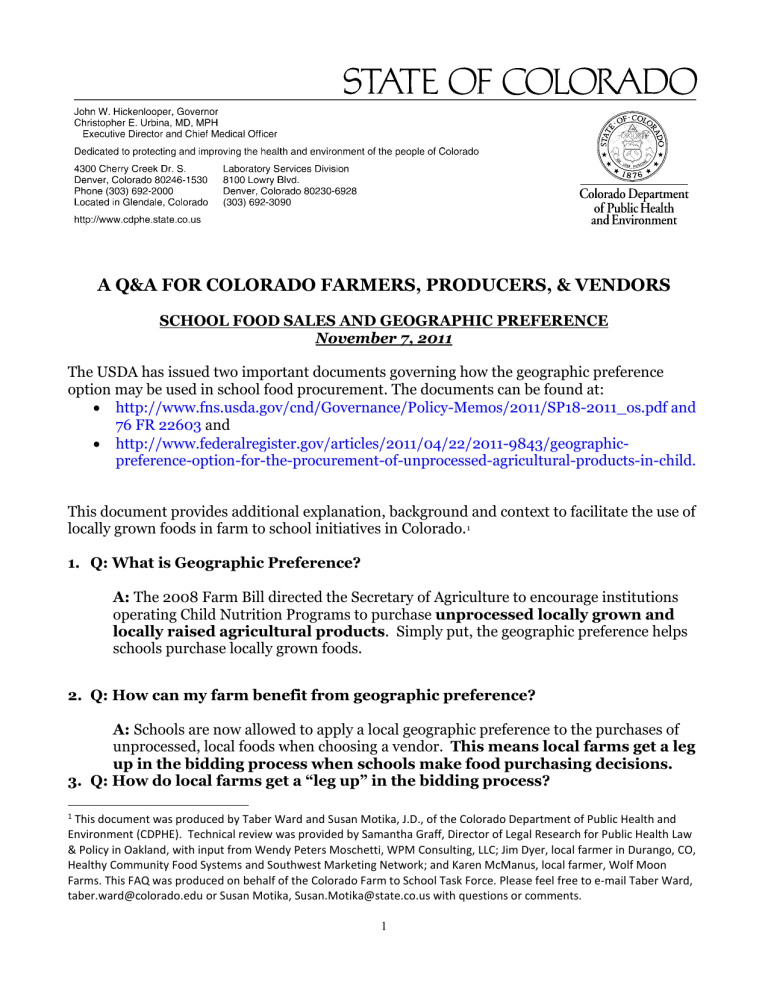FAQs – Geographic Preference Guidance for Local Farmers

A Q&A FOR COLORADO FARMERS, PRODUCERS, & VENDORS
SCHOOL FOOD SALES AND GEOGRAPHIC PREFERENCE
November 7, 2011
The USDA has issued two important documents governing how the geographic preference option may be used in school food procurement. The documents can be found at:
http://www.fns.usda.gov/cnd/Governance/Policy-Memos/2011/SP18-2011_os.pdf and
76 FR 22603 and
http://www.federalregister.gov/articles/2011/04/22/2011-9843/geographicpreference-option-for-the-procurement-of-unprocessed-agricultural-products-in-child.
This document provides additional explanation, background and context to facilitate the use of locally grown foods in farm to school initiatives in Colorado.
1
1.
Q: What is Geographic Preference?
A: The 2008 Farm Bill directed the Secretary of Agriculture to encourage institutions operating Child Nutrition Programs to purchase unprocessed locally grown and
locally raised agricultural products. Simply put, the geographic preference helps schools purchase locally grown foods.
2.
Q: How can my farm benefit from geographic preference?
A: Schools are now allowed to apply a local geographic preference to the purchases of unprocessed, local foods when choosing a vendor. This means local farms get a leg up in the bidding process when schools make food purchasing decisions.
3.
Q: How do local farms get a “leg up” in the bidding process?
1 This document was produced by Taber Ward and Susan Motika, J.D., of the Colorado Department of Public Health and
Environment (CDPHE). Technical review was provided by Samantha Graff, Director of Legal Research for Public Health Law
& Policy in Oakland, with input from Wendy Peters Moschetti, WPM Consulting, LLC; Jim Dyer, local farmer in Durango, CO,
Healthy Community Food Systems and Southwest Marketing Network; and Karen McManus, local farmer, Wolf Moon
Farms. This FAQ was produced on behalf of the Colorado Farm to School Task Force. Please feel free to e-mail Taber Ward, taber.ward@colorado.edu or Susan Motika, Susan.Motika@state.co.us with questions or comments.
1
A: Schools use an “Invitation for Bid” (IFB) to source food. In an IFB, the purchasing contract is generally given to the bidder who meets the specifications and has the
lowest price. According to the USDA, the purchasing agency for the school, also known as a School Food Authority (SFA) 2 , can give a preference to locally grown products through either the specifications or the price calculation.
As part of an IFB, the SFA could write specifications that include:
“picked within one day of delivery”,
“harvested within a certain time period,”
“traveled less than XX miles or hours,”
An IFB could also incorporate local preference into its price equation. For example, if a bidder meets the geographic preference, the SFA may deduct 10 cents from that bid for purposes of comparing it to other bids.
Example of how schools would incorporate geographic preference points in an
IFB through price equation:
Price
Meets geographic preference
Price w/ preference points
Bidder 1
$1.97
NO
$1.97
Bidder 2
$2.04
YES = 10 cents deducted from price
$1.94
Bidder 3
$2.00
NO
$2.00
Bidder 2 wins the bid.
* Note: Deducting ten cents from the prices of responsive bidders that met the geographic preference only applies to determining the winning bidder and would not affect the actual
price paid to a bidder.
4.
Q: How can my farm qualify for the geographic preference option?
A: Farms must meet two criteria to receive geographic preference priority:
1.
The farm must be “local.” The USDA does not define “local” but instead specifies that defining “local” is left up to the SFA. Producers and vendors should check with their local school districts or SFAs to determine if they qualify as a “local” farm. The term “local” should also be defined in SFA solicitations (i.e. Invitations for Bids or Requests for Proposals).
2 For purposes of this memo, all school food purchasing entities (i.e. school districts or any other purchasing entity) will be referred to as an SFA.
2
2.
Only “unprocessed” foods qualify under the geographic preference option. Under USDA rules, this means that agricultural products must maintain their “inherent character.” Specifically, this includes: ground beef and other ground products that do not contain additives or preservatives; frozen vegetables, including a combination of local products, such as carrots, broccoli and cauliflower; and portion sized or single-serving bags, such as apples or carrots. Thus, the legal definition of “unprocessed” allows for some minimal processing of food, such as freezing, grinding, chopping or bagging.
The USDA has determined that canned products do not maintain their inherent character and therefore are not included in the geographic preference option.
5.
Q: Are schools required to purchase local products?
A: No, an SFA cannot include language such as “we will only accept locally grown products” in a solicitation. Making local products a requirement can eliminate qualified bidders and thus SFAs may only “prefer” local foods in a bidding process and may not automatically exclude non-local foods.
6.
Q: If the bidder or supplier is incorporated outside of the state, but doing business in the state, can he/she be included in a geographic preference option?
A: Yes. A grower may be producing within state boundaries, but the business may be incorporated in another state. As long as the agricultural products are grown or raised within the specified location, applying a geographic preference is an option
7.
Q: What are the food safety regulations for local food producers?
A.
The USDA recommends that SFAs procure foods that have been grown under safe and sanitary conditions as outlined in the Good Agricultural Practices (“GAP”) and
Good Handling Practices (“GHP”) specifications. Ultimately, however, food safety requirements are designed by the school districts and SFAs. Producers and vendors should check with their local SFAs to understand school food safety regulations in their region.
8.
Q: Can my farm still use the “informal bidding process” to negotiate with SFAs under geographic preference?
A: Yes, a geographic preference is available under the informal bidding process. The informal bidding process may be used by SFAs procuring food under the small purchase threshold of $100,000. However, this threshold is oftentimes lower than $100,000 in
3
Colorado, as local school districts can set this amount. Producers and vendors should check with their school to find out what the small purchase
threshold is in their district.
9.
Q: Can producers or vendors split up sales into smaller amounts in order to fall under the small purchase threshold?
A: No, producers and vendors cannot intentionally split purchases in an effort to avoid more rigorous procurement standards. However, in some situations, it may be appropriate to separate particular items from overall food purchases. For example, produce, or specific produce items, may have a limited shelf life when compared with other products. Bread and milk are typically set aside from large overall food purchases because of their shorter shelf life and durability.
4









